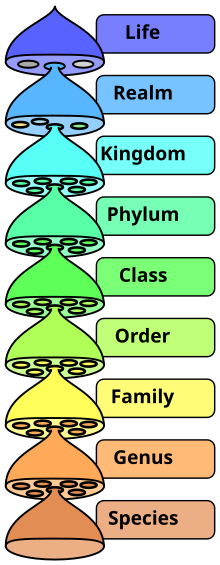
Back تصنيف الفيروسات Arabic Класификация на вирусите Bulgarian Classificació dels virus Catalan Klasifikace virů Czech Virusklassifikation German Ταξινόμηση ιών Greek Clasificación de los virus Spanish طبقهبندی ویروسها Persian Classification des virus French Clasificación dos virus Galician

Virus classification is the process of naming viruses and placing them into a taxonomic system similar to the classification systems used for cellular organisms.
Viruses are classified by phenotypic characteristics, such as morphology, nucleic acid type, mode of replication, host organisms, and the type of disease they cause. The formal taxonomic classification of viruses is the responsibility of the International Committee on Taxonomy of Viruses (ICTV) system, although the Baltimore classification system can be used to place viruses into one of seven groups based on their manner of mRNA synthesis. Specific naming conventions and further classification guidelines are set out by the ICTV.
In 2021, the ICTV changed the International Code of Virus Classification and Nomenclature (ICVCN) to mandate a binomial format (genus|| ||species) for naming new viral species similar to that used for cellular organisms; the names of species coined prior to 2021 are gradually being converted to the new format, a process planned for completion by the end of 2023.[needs update]
As of 2022, the ICTV taxonomy listed 11,273 named virus species (including some classed as satellite viruses and others as viroids) in 2,818 genera, 264 families, 72 orders, 40 classes, 17 phyla, 9 kingdoms and 6 realms. [1] However, the number of named viruses considerably exceeds the number of named virus species since, by contrast to the classification systems used elsewhere in biology, a virus "species" is a collective name for a group of (presumably related) viruses sharing certain common features (see below). Also, the use of the term "kingdom" in virology does not equate to its usage in other biological groups, where it reflects high level groupings that separate completely different kinds of organisms (see Kingdom (biology)).
- ^ "Virus Taxonomy: 2022 v3 Release". ictv.global. International Committee on Taxonomy of Viruses. Retrieved 5 January 2024.